|
|
Geoffrey
B. Small
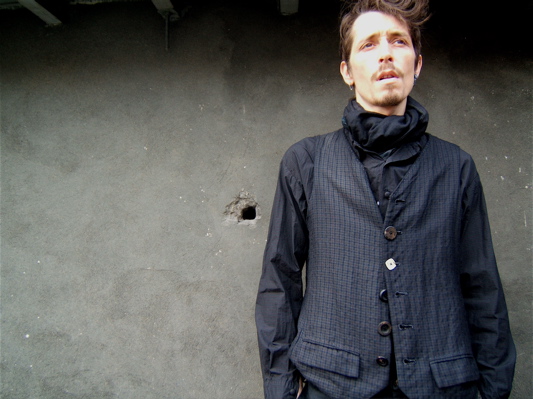
Superlux hand
made waistcoat in hand dyed pure Alashan
cashmere woven by
the oldest
wool mill in the world, Fratelli Piacenza
1733.
Scoute
sat down with Cavarzere Venezia based, American
born creator
of hand-made garments Geoffrey B. Small during
last Paris men’s fashion
week to discuss his personal journey through the
changing fashion
landscape of the last thirty years and his
status as the American
designer with the longest running Parisian
presence.
While
tailoring Renaissance man Small’s past
experiences and vision
for the future are truly enlightening, let us go
back a step and make
explicit where Scoute stands regarding Fashion,
that magnificent and
horrible word that we sometimes fear to utter
aloud, in the vain aim of
avoiding being associated with frivolity and
faddishness.
There
has been talk of a Scoute aesthetic, a taste for
the macabre,
brooding clothes of designers that thread the
dark corners of the world
of, well, dressing up people to look dangerously
cool. Some would say a
thin veneer of ready-to-wear aggression,
available to whoever has the
fortitude of spirit and wallet to buy his entry
into the black-clad
elitist club. This derisive outlook overlooks
the true center of what
we stand for. What those brands, shops and the
passionate individuals
who are at their core share is not so much an
aesthetic stance as an
ethical one.
Consequently,
we believe that presenting Geoffrey B.
Small is not
only an introduction to the work of an important
designer but an
exemplary illustration of that ethical stance.
That his work looks
different from what you would expect to see in
Scoute is merely a sign
that you should revise what are your assumptions
regarding the
magazine’s mission.
The
Geoffrey B. Small narrative
|
|
|
Let us go back to a time
far, far away when the Italian men’s
magazine, L’Uomo Vogue, presented new and exciting
designers, in tune
with the world they lived in and devoid of the
stultification that
would stop them from morphing to continue to
reflect it. This may seem
ludicrous if you never had the chance to see the
magazine in the 70s
but it once presented something beside cocktail
dresses worn by
celedebutantes, star designers and dream weekends
in Spanish villas
reminiscent of the manicured emptiness Antonioni
relentlessly exposed
in his films. Two promising unknowns called Armani
and Versace were
unleashed in a terse, two paragraphs blurb at the
back of a 1977 issue
and they put forward new silhouettes, fabrics and
philosophy that
captivated the young Geoffrey. Here were designers
that would turn
men’s clothing design on its head and set the pace
for what would be
worn throughout the 80s. Since childhood, Small
had continually
expressed himself through illustrations; |
Hand
made jackets hang dry in the Cavarzere sun
as part of Small's special hand dyeing process.
|
|
|
drawing
the “toys he could not
have” (can a kid ever have all the toys he wants?
Get your children a
pen and some sketchpads!), a passion that evolved
during his
adolescence to sketching clothes he wished he
could purchase, many of
them found at the venerable Boston retail
institution, Louis Boston.
“They were one of the very first
retailers in
America to start
introducing what was really going on at the time
in European design,
especially Italy. I started getting serious about
a career in the
field, and wanted to work there and learn from
them, but it didn’t work
out that way…”
|
|
|
Most
of Small's design pieces are dyed by hand, an
arduous and time consuming process that is
centuries-old.
|
Unable to secure
employment at the
exclusive store of his dreams, Geoffrey started
working at The Gap, a
retail company more open to hiring an
inexperienced 17-year old boy. He
enrolled at a local fashion design school,
spending his days working
the sales floor selling and folding jeans and his
evenings beginning to
learn the prosaic but highly useful techniques of
patternmaking,
construction and sketching.
The year of 1979 turned out to be pivotal for
Geoffrey as, through
his schooling, he was able to participate and went
on to beat over
14,000 entrants, winning the ILGWU “America’s Next
Great Designer
Awards” the largest student design competition in
North America. The
following year Small’s talent was again recognized
at the ILGWU, now
boasting 20,000 entries, by a prestigious jury
composed of the likes of
Bill Blass, Elsa
Klensch, Calvin Klein and Geoffrey Beene.
|
|
|
Geoffrey
would go on to win more design competitions, often
boldly disregarding
the dominant American aesthetic of the times and
surprising juries with
his use of the brash silhouettes and understated
colours inspired by
the movement Giorgio Armani had started in Italy.
Now having caught the eye of a few American
recruiters he was tempted
to make his entry into the world of NYC fashion
houses but he quickly
found out that, although the innovative
silhouettes he inked on paper
genuinely impressed his potential employers, the
need of the American
mass market meant he would have to tone them down
so much as to make
them undistinguishable from the comparatively
bland American designs of
the times. Geoffrey remembers with his typical
humour a meeting with
Stanley Kimmel, the president of Jones Apparel
Group in New York (which
now produces a large part of Ralph Lauren’s
collections), to discuss
his taking over the men’s design position, who,
praising his sketches,
proposed a few, minor, modifications: “Nice
shoulders but we’d need to
make them a little narrower! Excellent waist
suppression but our
clients can be quite portly, let’s remove some of
it! Beautiful choice
of wrinkled fabric, but highly inappropriate for
the bankers and
lawyers that need a more conservative suit!”, the
final result ended up
being so watered down that it was identical to
what the company had
been putting on the racks for years.
|
|
|
“My passion was never to
do what
was already being done by others, especially in
the U.S.. I wanted to
take it to another level. At the time, believe or
not, Milan was the
super-cutting edge of world avant-garde. They were
doing what everybody
was eventually going to do after them. And that’s
exactly what I
eventually wanted to do with my own work. I talked
to other designer
colleagues whom I met in various competitions—all
of them prize-winners
and they were all in the same boat. I realized
then and there, that I
would have to control my own production and run my
own business in
order to be able to design the clothes I wanted
to. Nobody else was
going to make it happen, except me.”
By this
time, beginning to be able to sew, he decided
to start a
small laboratory business, making clothes for
friends using an old
Singer sewing machine and the space available in
his parent’s attic.
This focus on the use of the basic
skills of the trade
and a belief in
self-reliance stayed with him to
this day.
|

Handmade late 19th century 14-button
double-breasted babysoft hand
dyed Piacenza cashmere
and silk jacket.
|
|
|
Without being
part of the
punk musical and artistic movement emerging in NYC
at the time, Small,
always sensitive to social undercurrents, soaked
in the do-it-yourself
ethic of those years and applied it to a calling
of his own.
Do it yourself
These
encounters with the business-minded but
conservative American
market only served to reinforce Small’s DIY
ways. He opted to continue
building his small company and trying to teach
himself the tailoring
techniques of past masters. This, arguably
intransigent way of doing
things, may seem counterproductive for a young
designer trying to break
through but Small readily admits that wanting to
be a designer’s
designer is, to him, worth paying a commercial
price. Geoffrey was and
remains the talented indie act that progresses
at his own pace but
remains relevant, thirty years later, having
seen more high-profile
designers come and go, without ever feeling the
need to put down or
attack those choosing a different way.
The
intensive technical and business experiences of
the
80s would
lead him to become, at the dawn of 1990, the man
behind the leading
bespoke tailoring house in Boston. He offered,
in his Newbury street
ateliers, painstakingly constructed suits for
men and women, counting
among his clients such diverse individuals as
the Governor of
Massachusetts and pop act New Kids on the Block.
|
|
|
Geoffrey shows a deep
respect for the intricate
work of bespoke tailoring, “an honourable
profession when done right”,
as he pointedly reminds us. The relationship is
personal and often
extends over a long stretch of time resulting in
numerous outfits
reflecting the meeting of the tailor and client’s
personalities,
lifestyles and interests. To Small dressing
someone is not a science
where a golden ratio must be respected to ensure
optimal results, but
an applied art that gives credence to individual
quirks. Here the
technical meets the relational. “People talk with
their clothes. They
say who they are, or who they want to be. A great
tailor has to get
into people’s heads, know their bodies and their
needs, and then create
and execute the very best solutions for that one
person. You have to
really know your client. And you have to be a real
master of your art
and craft. Unlike runway ready-to-wear, you can’t
fake it. You have to
look your customer in the eye, right there in
person. There is nowhere
to hide.”
With
that being said, Geoffrey after almost a decade
and half of
learning the tradition now felt ready to add to
the fashion symphony a
few notes of his own, and that is why he started
showing ready to wear
collections in Paris in 1992, notably presenting
his second collection
at the original Paris sur Mode salon organized
by Jean-Pierre Fain, an
alternative event held outside traditional
venues, on the banks of the
Seine. Fashion insiders had the chance to
discover his work alongside
the comeback collection by Roberto Cavalli and
the very first Carpe
Diem collection by Maurizio Altieri.
|
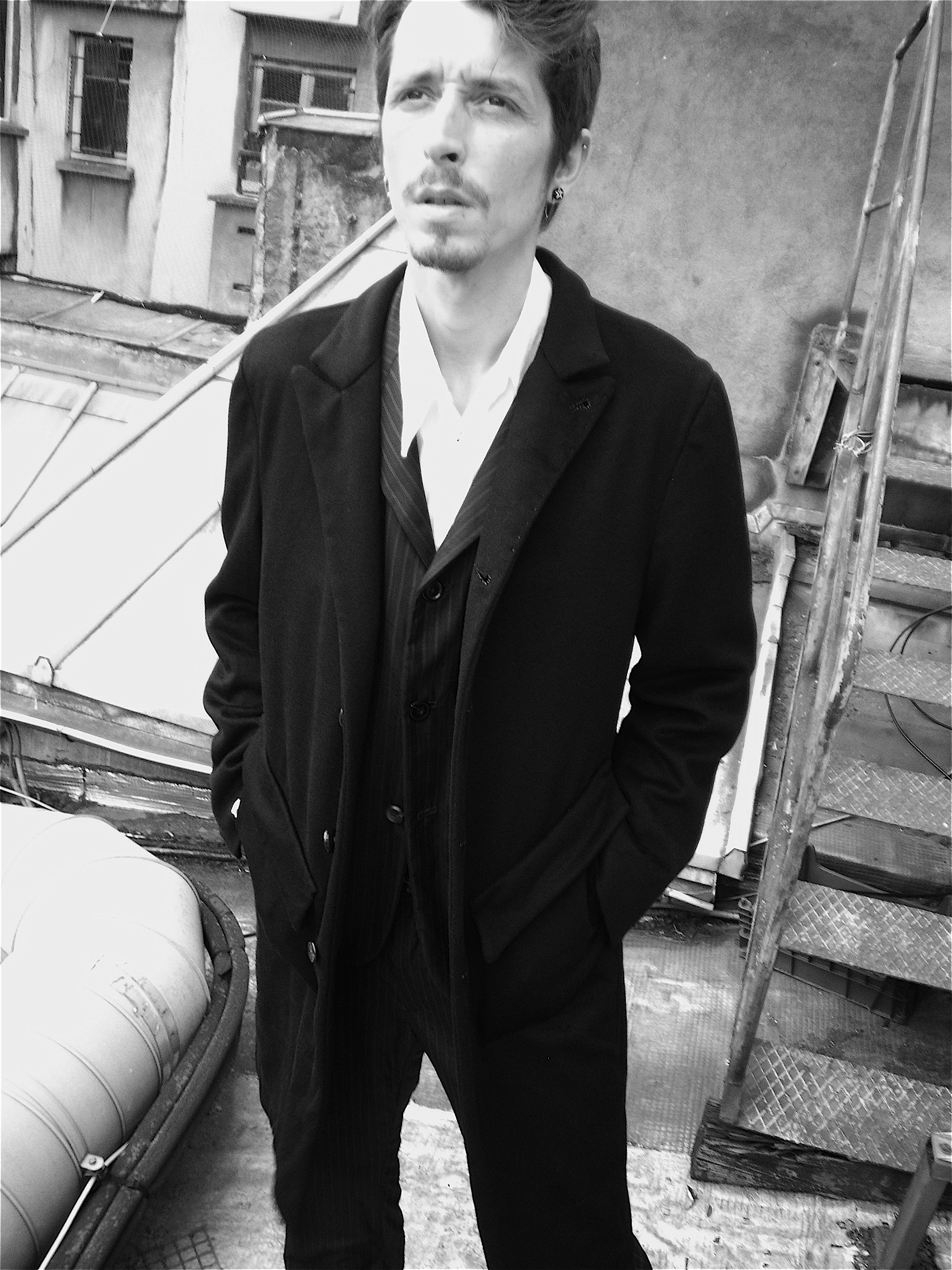
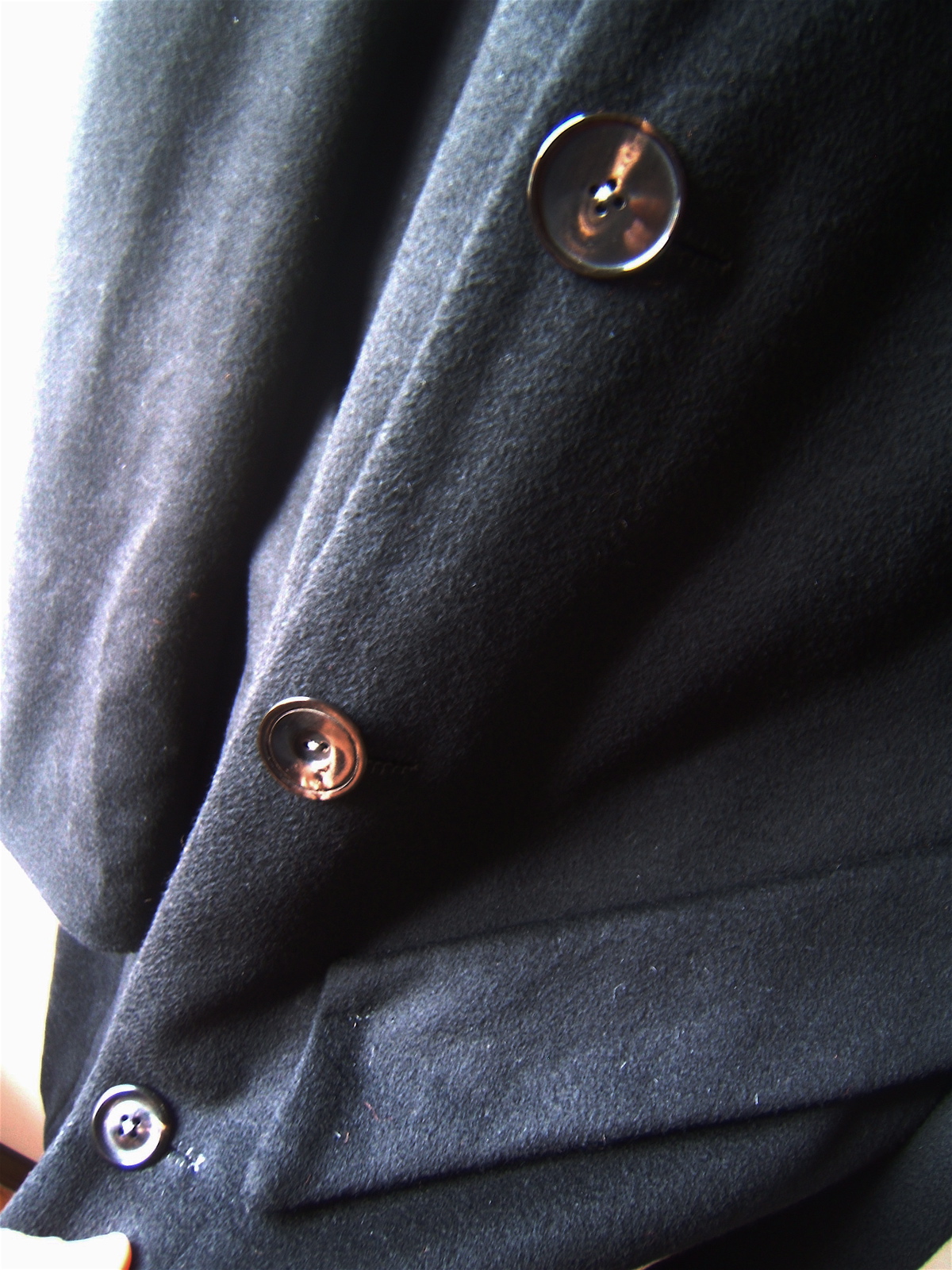
Hand washed Piacenza cashmere
& wool
topcoat with real
horn buttons. artisan-made
in Parma.
|
|
|
“It was exciting.
Nobody from America
had ever showed in Paris before us except
Patrick Kelly,
who had moved there and died very young, and
Oscar de
La Renta who of course was
very
classic and
ladies-who-lunch. And
nobody had ever
tried to do Paris avant-garde from
the
U.S.. We were the first, and we had to go up
against the likes
of Comme, Yohji, Martin, Helmut Lang, the
first-wave of Belgians (Ann,
Dirk,), all of them pioneers. And believe me, they
were kicking out
tremendous work in those days; the best in the
world. At the time
nobody in the circuit thought Americans could even
hold a candle in
Paris…could create first-in-the-world design work,
American designers
were known strictly as giant commercial copiers
who sold only in their
home country. We were poor, went over there on a
shoestring. But we
were hungry, and focused on our Art, and made an
impression when we
started, and after a few years there was a wave of
Americans showing in
Paris from Jeremy Scott to Marc Jacobs, to Rick
Owens and even Tom
Ford. Prior to us, there was no one. We opened the
door. People would
ask us why do you show in Paris instead of New
York? I always told them
Paris is the most competitive designer arena in
the world, it’s where
the Art form lives or dies. Each time you get back
in, it makes you get
better.”
To this day Geoffrey B. Small stills
present
collections in Paris,
now eschewing runway presentations to focus on the
visceral experience
of the showroom, an environment where the clothes,
unadorned by
theatrical flourishes, are there to be touched and
viewed as they will
be approached in shops and seen in the wardrobes
of discerning wearers.
Geoffrey remains to this day the American designer
with the longest,
uninterrupted presence on the Parisian fashion
calendar (now on his
63rd Paris avant-garde collection), having been
over the years praised
by Collezioni, Vogue, Women’s Wear Daily and the
perceptive Pierre
Bergé. You may also remember a feature on his 2006
collection,
“An Ode to Toussaint Louverture”, shot by the
ever-present Karl
Lagerfeld.
Tradition and modernity
|
|
|
While the Geoffrey B.
Small story presented
earlier may be construed as a run of the mill rag
to riches narrative,
replete with references to humble beginnings and
concluding on the high
note of Parisian consecration, it mainly serves to
highlight his
approach to learning and growth. Having taken to
heart the mantra of
Mr. Armani, who stressed the importance of knowing
the entire process,
Small took it a step further and elected to take
direct control of it.
Most fashion companies are run like typical
corporations where the
skills that are judged central to the brand, such
as sketching and
design are kept in-house and everything else,
production being a major
example, is subcontracted. In a sense this mirrors
the transition from
art to commercial art enterprise that such high
profile conceptual
artists as Damien Hirst and Takashi Murakami,
inspired by Andy Warhol,
have perfected by coming up with ideas and overall
designs and
commissioning a third party to ensure production.
|

Hand tea dyed Varese
superfine pure linen
hand made jacket and waistcoat.
|
|
|
While
the final product is often of high technical
quality, the value is mainly derived
from the idea and the “branded image” of the
artist. We are reminded of
the exchange between Hirst and one of his
collaborators handling the
actual creation of a series of dot paintings,
where she requested he
sign a work she made for herself, knowing full
well the value resided
in the provenance of the signature and not the
physical object.
Small
has a different approach, like a traditional
artist or
artisan, he puts as much effort in the crafting
of his garments as he
does in perfecting the designs. “Most consumers
and designers don’t
understand that the making is
the design. A designer is always limited by his
production. You’re only
as good as what your production is capable of
making. The better we can
make things, the better the things we can
design. To design the best
clothes in the world, you have to be able to be
the best clothes-maker
in the world. This has been our continuing
mission since 1979.”
This
applies to his supplier network as well. With
almost a decade
in Italy, not in Milan, where virtually nothing
is made anymore, but in
the rural hinterlands across northern Italy
where the real guts of the
Italian textile and clothing industry are found,
he has slowly built up
tight relationships with the very best fabric,
material and accessories
makers in the country—the absolute top of “made
in Italy.” From the
world’s oldest woollen mill and greatest
cashmere house Fratelli
Piacenza in Pollone Biella (founded in 1733), to
the last remaining
handmade button-makers in Italy (Parma), to
individual medieval artisan
specialists in shoe-making and metalworking
design—Small’s ability to
make unique, beautiful and valuable works
continues to expand deep
roots backed by an ever strengthening
foundation.
|
|
|
For
Spring/Summer 2010 he is going even
further, for the first time being able to be
completely involved in the
making of the cloth itself, that he will, as
before, later cut and sew.
He has developed a unique relationship with
Luigi Parisotto and his
family, who collectively have over a century of
fabric weaving and
making experience. The Parisottos are located
north of Vicenza, in the
town of Sarcedo, at the foothills of the alps.
Small describes their
partnership as the collaboration of two master
artists, going above and
beyond a simple fabric supplier-designer
relationship. Able to discuss
thread count, types of cotton, linen or cashmere
compositions and modes
of yarn spinning and weaving, he can clearly
share his vision for the
completed product and has convinced his partner
to create small runs of
slowly spun, peculiar fabrics, with a tactile
feel of beautiful
irregularity reminiscent of pre-Industrial
materials. To further relay
that unique influence, Small foregoes the final
steps of normal factory
finishing and washing fabrics and handles this
crucial part by hand
himself, going as far as to do every piece in
the bathroom of his
apartment studio in Cavarzere. The normalizing
process of washing and
chemically finishing, helping to give fabric its
smooth, even sheen is
thus subverted, or rather brought back to its
original form, and
results in uniquely wrinkled materials, ensuring
distinct results for
each piece coupled with enormous reductions in
carbon emissions and
chemical impacts to local water and environment.
Taking
advantage of his bespoke tailoring years, Geoffrey
designs,
cuts and constructs each garment by hand with the
help of a small team
of 4 highly trained, dedicated and disciplined
designer-tailor
associates. Casual, uncanvassed jackets with
hand-stitched collars,
real hand stitched buttonholes (a job requiring 8
to 10 minutes per buttonhole),
hand finished sleeve cuffs
with
working buttonholes and,
ultimate rarity, hand stitched lapel holes. |
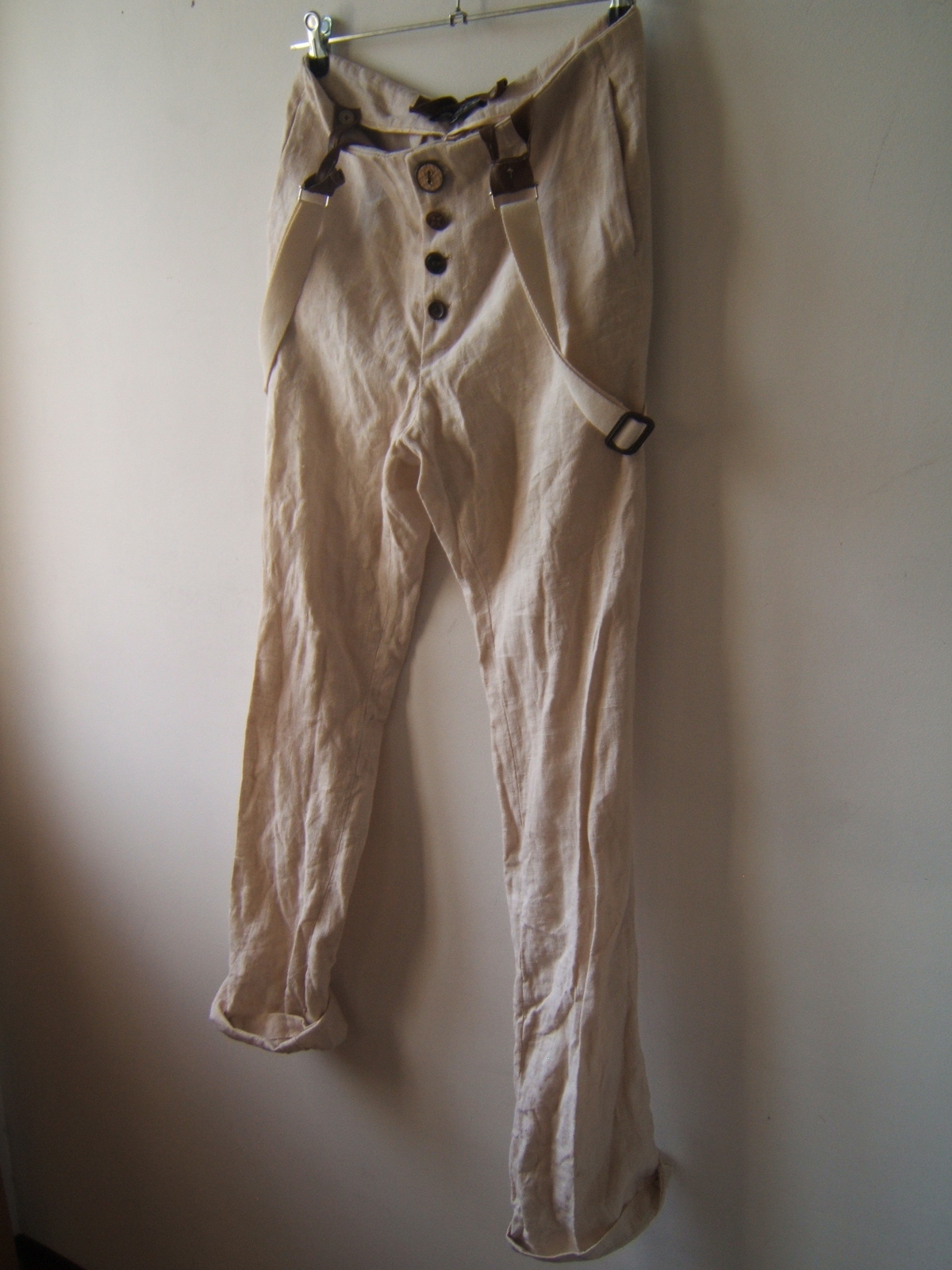
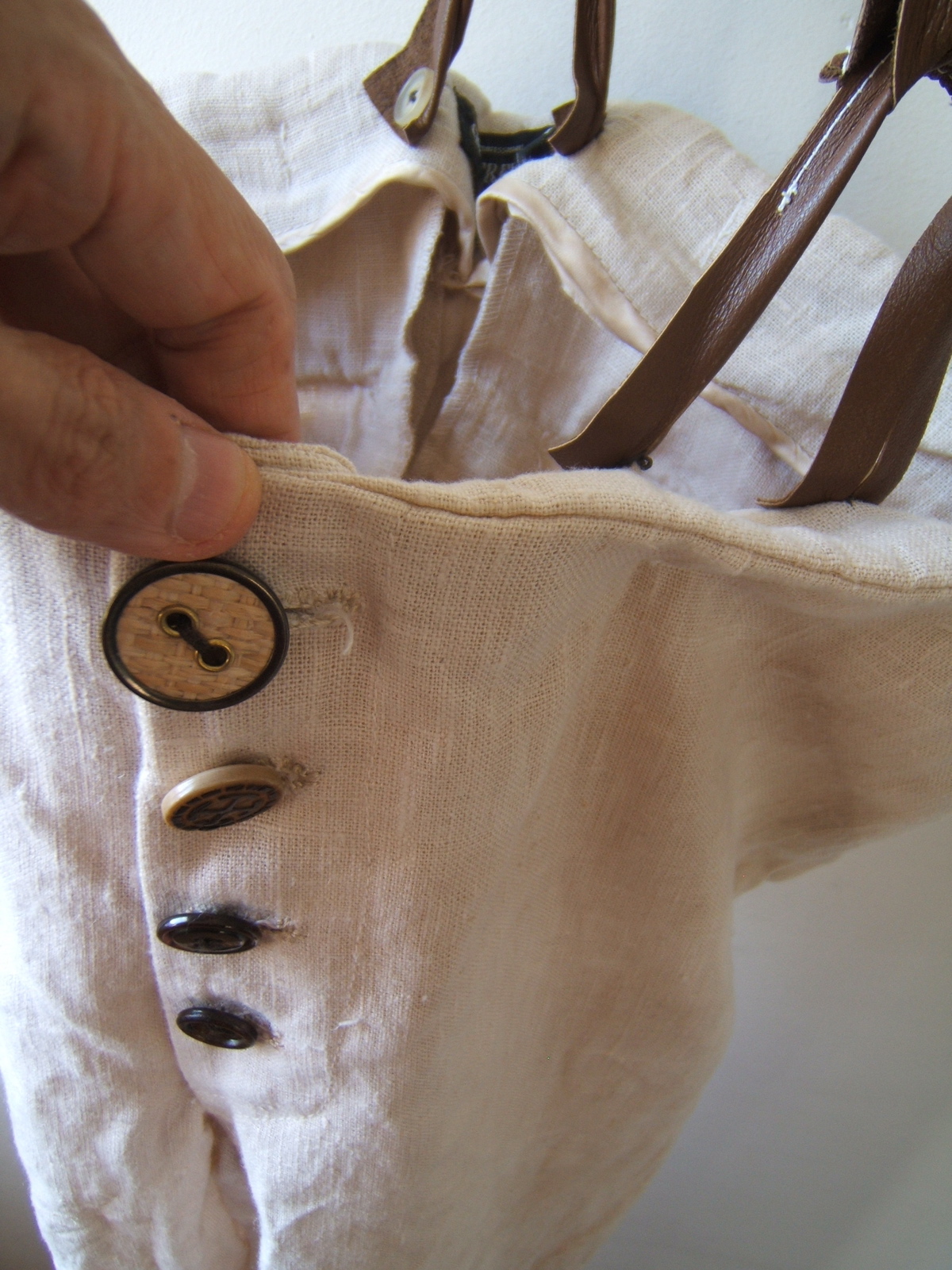
Hand dyed Varese
low gauge handmade pure
linen trouser,
vintage leather suspenders and straw, nut and
wood buttons.
|
|
|
The
pieces, light as
feathers, mould to the wearer’s body and stand as
shining examples of
the disappearing art of hand-made garments. To use
an automotive
example the typical designer suit would be a
Mercedes, the result of a
well-oiled factory process privileging
cutting-edge machinery and a
posteriori quality control with each worker
handling a separate piece
of the puzzle. A Geoffrey B. Small blazer or pair
of pants is a
lovingly crafted custom Rolls Royce, or better yet
a Koenigsegg, each
piece hand finished by a worker who is in fact,
the designer himself,
handling the whole process and ensuring a perfect
integration of all
parts, a time consuming labour of love that few
are willing to even
learn, let alone put into practice. Such an
uncompromising, pre-modern,
and in Small’s view, post-modern approach results
in unparalleled
quality but has its price; less than 500 Geoffrey
B. Small garments are
made each season and they can only be found at
exclusive boutiques
catering to a crowd of passionate clients, looking
for the human magic
of the unusual in a world of mass-produced
repetition. By moving the
fetishism to the process, Geoffrey has managed to
remove it from the
commodity, creating an item that derives its value
from the quality and
the spirit of its construction, materials and
design.
The designer & the world in which he
lives; an ethic of fashion
design
I-D
magazine in their classic “Fashion Now” books
profiling top
fashion designers often ask their interviewees
their feeling on the
possibility fashion has of changing the world we
live in, most choose
to dodge the question to concentrate on their
love of pretty shoes.
Geoffrey does not wait for you to ask; he dives
right in to the topic
and makes it the centerpiece of a well-rounded
conversation. To him,
designers are linked to the world they live in
as fish are to the sea,
while his peers may chose to live in a pristine
aquarium he knows the
world affects him and hopes to do his small part
to exert a positive
influence on it.
|
|
|
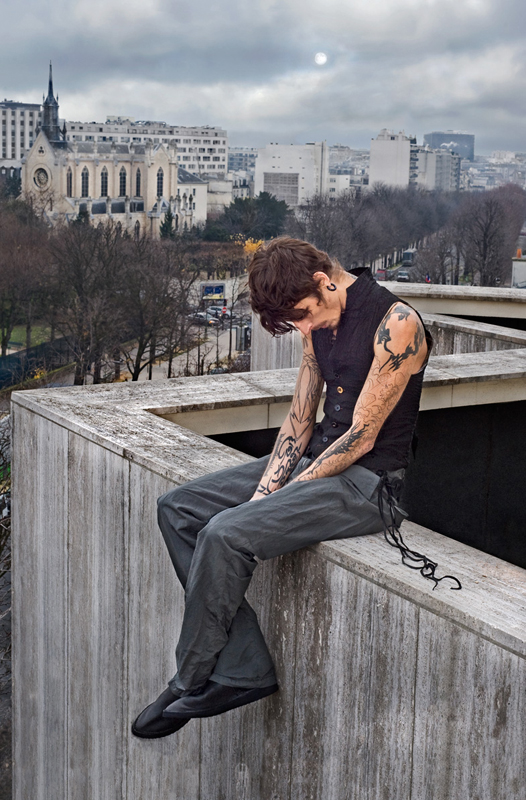
Hand dyed Vercelli
silk, wool & viscose waistcoat with
Varese silk & cotton superlight hand dyed
trouser.
|
“Fashion is an Art.
That’s why I do it. And
artists have a responsibility to themselves and
their audience. For
those of us lucky enough to still be in this line
of work–To speak the
truth, not lie about it. And to do whatever we can
to make life better
for people, not just an elite few. And these days…
there is plenty to
do.”
Being
based in Italy he has seen the ravages of
delocalisation that
has left large numbers of textile and clothing
workers unable to find
work after the closing of their factories. The
labour market is not
kind to people that only know how to sew a
pocket once their initial
workplace closes. In this light, his urge to get
to know the full
process and to become an iterative learner takes
a prescient edge.
“For
those of us in Italy who are still practicing
masters of our
work in all the related fields, our biggest
|
|
|
concerns
are about finding
and educating a new generation of masters who can
carry the crafts
forward. Otherwise, the skills and the know-how
will be lost forever. I
teach all the time. But it is very challenging
today, and difficult to
find young people willing to pay the real price
necessary for achieving
mastery in an Art. It’s a lifelong commitment, and
it’s not about easy
stardom or quick money. It’s a disciplined way of
life that requires
sacrifice, commitment, talent, passion and
patience. And it’s not at
all easy, especially in the current decade.”
The fashion world has become a way for him to
communicate his
concern to others and act as a mirror in which we
may contemplate the
present. As an American concerned with the
direction his country of
origin was taking after the tragic events of
September 11, he was the
first in Paris to come out publicly against the
upcoming invasion of
Iraq (January 2003), in January of the next year
he presented the
“Brumaire revisited” collection, a
Napoleonic-themed show that preceded
a slew of similarly inspired collections or pieces
by the likes of John
Galliano, Chanel, Dolce & Gabbana, Dior Homme
and Undercover. While
the influence of this landmark 2004 collection on
the fashion scene is
undeniable, it also allowed Small to get across
his position regarding
pre-emptive wars and aggressive international
policies, a subtext that
was not as easy to recuperate as the beautiful
18th century military
outfits displayed on the runway. Finding much
inspiration in the
garment designs of the past and faithful to his
method of assimilation
followed by innovation, he managed to apply the
same mindset to his
messages. The middle-ages were recontextualized in
the years following
2006, as Geoffrey compared growing social
inequalities to a form of new
global feudalism, explored the place of women in
current social
hierarchy, discussed the growing problem of
illiteracy in modern
societies, and introduced some of the world’s
first clothing designed
to address global warming.
|
|
|
Spring/Summer 2010 saw Small put the idea of a
leading-edge sustainable wardrobe, sturdy,
comfortable, multi-purpose
and unique enough to resist years of faddish
changes to the foreground.
In these times of economic and political
uncertainty, a client may
never know when he can purchase clothes again
and these new garments
will remain wardrobe staples long after the
world has underwent
post-apocalyptic changes rivalling the Mad Max
universe, or so we hope.
Suffice to say that once you have tried them on,
the thought of wearing
them day after day does not sound like torture
but clothing nirvana.
|
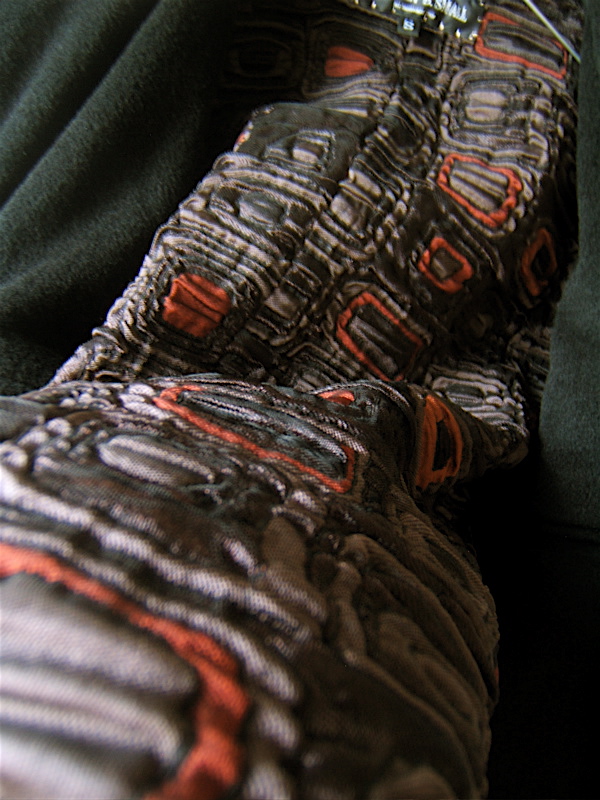 
The
new direction: a visual story inside that
may be more poignant than the
exterior.
Above: special exclusive vintage lining
(Como), handmade
working buttonhole sleeve cuffs.
|
|
|
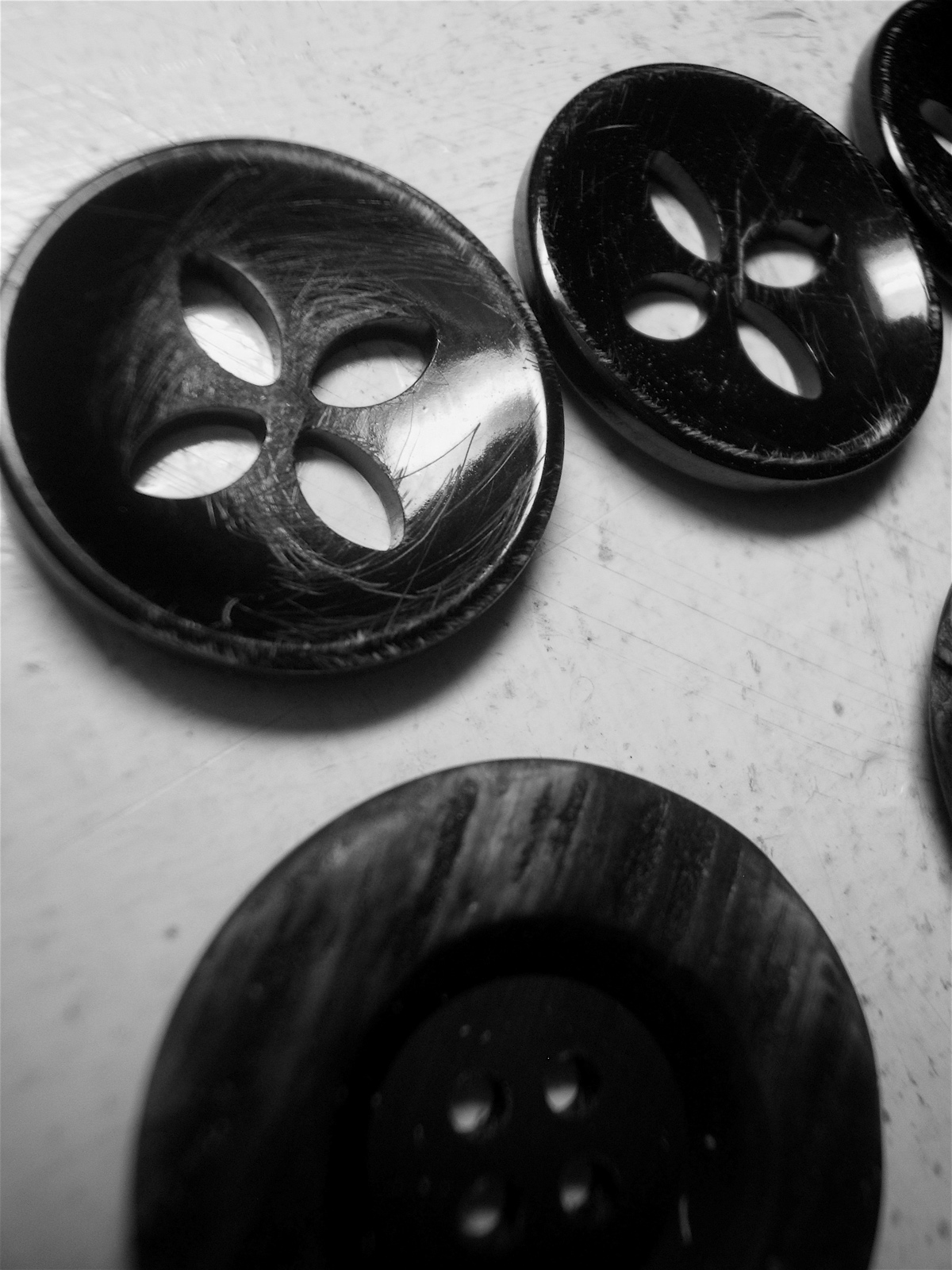
Special real horn buttons are finished by Small
with 2 different types of West German sandpaper.
"We spend more for our buttons, than most
designers spend for their main fabrics--it's part
of our Art."
|
“To me today’s
avant-garde is about the inside of clothes, how
they
feel and how they last, how they protect you.
People cannot afford to
only deal with exteriors now. It’s not about the
outside anymore. Of
course, it has to look good, it has to fit, and it
has to be cool—but
there are landfills of that kind of stuff
available right now. And the
customer knows it. Show me something that will
keep you alive and
comfortable if you lose your house tomorrow, a
tragedy faced by 1 in
every 50 people in the world in 2008. I feel a lot
of cool designers
and stores are still back in the late 90’s/early
2000’s mentality, but
I lost interest. Been there. Many of them are my
friends. But I am
really on to a different thing. Every piece I make
now has to be
comfortable, really comfortable–good
enough to sleep in. For ten years. It has
to have a visual
story
inside that may be more poignant than the
exterior...
|
|
|
I spend more
on linings and buttons than a lot others
are spending on their main
fabrics. The idea is to have no carbon or methane
footprint, no
plastic, poly, chemicals, landfill problems,
unsustainability, animal
cruelty, human exploitation or
slavery in its
manufacture. We have a
higher component of handwork in our clothes than
any collection showing
in Paris. Handwork is carbon neutral and builds
craft and gives dignity
to people who do the work….Something that’s worth
every penny you
spent, doesn’t hurt anybody, lasts you a lifetime,
makes you feel good,
and yes, looks really good too, every time you put
it on. That’s the
new direction fashion needs to take, and that’s
where I am focused. The
world’s greenest designer concept at the Paris
collections-level.”
|
|
|
While not every designer
discussed by Scoute makes his principles as
explicit and readily intelligible as Geoffrey B.
Small, it is this
shared ethos that draws us to their work. They
have respect for
tradition that follows the dictum of learning,
imitation then followed
by innovation; they treat seasonality as a way to
build upon a corpus
of work instead of an ever-changing attempt at
aimless renewal ; they
value craftsmanship and technical knowledge and
they realize that a
broad cultural horizon that goes beyond fashion is
the way to bring
soul to a design thus capturing that indefinable
quality that makes a
garment a passageway to the wearer’s individual
expression. Human
rapport is central and not mediated by countless
faceless entities;
creators participate in the whole process, from
fabric weaving to
dealing with store buyers.
|

Expensive pure silk Bozzolo Reale
Milan threads used for handstitched buttonholes
and hand detail work.
|
|
|
"It’s
about 30 years of work, people, and resources,
putting it all
together, and making the very best clothes we
possibly can with
everything we’ve got. Then raising the bar one
more time even higher
for the next time… that’s what makes it fun.” |